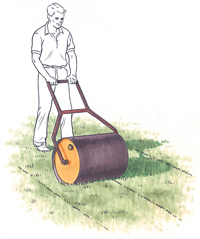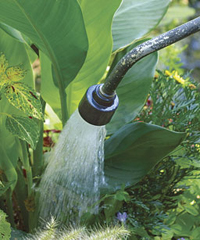
Als Tips
POST-SOD CARE
Once you've laid all the sod, put all pieces into place and tucked all the edges, you should roll the area. A water roller is a drum that is filled with water to give it weight. Rolling the sod will improve root contact with soil and remove any air pockets. Air pockets can reduce establishment because there is little contact between roots and soil. Better root-to-soil contact will quicken the pegging down of roots into soil and establishment.
Water sod as soon as possible. If sod is out on dry soil in the full sun for a couple of hours before watering, die-back can begin and increase the amount of time for establishment. Water until the soil beneath is wet. Pull up pieces in several areas to insure that adequate penetration is achieved. Water everyday for a week if there is no rain. All the roots are located in the sod, so the turf is dependent on irrigation for water requirements until it can establish a root system in the soil. In hot weather, you may need to irrigate sod more than once a day to cool it as well. Continue watering frequently for the first two to three weeks and avoid dry soil. Once roots have established after this period, water less frequently and more deeply to encourage deep rooting. Apply an inch of water per week over two to three applications.
Cracks usually appear when sod has been allowed to dry too much or pieces have not been fitted tightly. You can fill these cracks with soil to level the ground and reduce further drying out of edges. Once established, the turf will tiller outward and fill the cracks.
Do not fertilize until the sod has pegged down. Turf is under a great deal of stress because it has had greater than 90 percent of its root system removed. Fertilizer will be most efficient and effective when you apply it after roots have firmly penetrated the soil. Apply one pound of nitrogen per thousand square feet, then follow fertilizer recommendations after that.
Mow the sod only once it has pegged down. Mowing too soon can pull pieces up into the deck and shred them. Mow at the proper height so that no more than ⅓ of the topgrowth is removed.
INSTANT TURFGRASS
Customers usually are satisfied with the additional costs of sodding because they see a yard of bare soil turn into a stand of mature turf overnight. There are few weed problems to tolerate and establishment requires much less effort than seeding.
Tony Bertauski is a horticulture instructor at Trident Technical College (Charleston, S.C.

HOW TO WATER NEW PLANTS
Watering new plants correctly is critical to the life of the plant. Either too little or too much can kill it.
Balled and burlapped plants lose a great deal of their root system when they are dug. Because there are fewer roots to draw water into the plant, the remaining roots need to take up more. In turn, the remaining roots need even better care.In general, water balled and burlapped plants while you backfill the hole in which you planted them and again when the planting is finished. Then water thoroughly the next day. These two waterings help the soil settle around the roots and reduce the size of air pockets. Water again the third day and then every 7 to 14 days as needed for the next several weeks.
Container grown plants are transferred from the pot to the soil with virtually no root loss and can easily continue on a regular watering schedule. After a few initial soakings, water container grown plants once a week for three to six weeks.
For the balance of the season, I would follow a general rule of watering newly planted balled and burlapped plants once every ten days to two weeks for the next eight weeks, then once every two to three weeks for the remainder of the growing season, watering thoroughly each time. Container grown plants should be watered once every two or more weeks for the balance of the first year and the following season.
Thorough watering occurs just before flooding the plant, when a puddle appears on the surface of the soil and does not soak in. Soil varies and different locations on the same site will vary in the rate at which water is soaked in. It is far better to water more thoroughly and less frequently which allows excess water to drain beneath the plants roots.
You can test the soil to determine if it needs watering after the third to seventh day by taking a three foot long wooden stick and inserting it into the soil up to a foot deep. It's kind of like inserting a toothpick into a freshly baked cake to see if it's done. Remove the wooden stick and if it is very wet at the bottom, don't water. This procedure is where watering moves from a science to an art. The measuring stick is especially helpful during periods of frequent rain when the newly planted shrub or tree may not need to be watered as frequently, if at all. A parched surface doesn't always indicate the need to water.Proper watering of newly planted trees and shrubs is critical. If you have any questions ask your installer or local landscape professional, nursery or garden center where you purchased them for help.
USING YOUR POND PRODUCTS
When used as suggested your pond will look better and be more enjoyable. All dosages are based on gallons of water in the pond which can be calculated by multiplying length (ft.) x average width (ft.) x average depth (ft.) x 7.48.

AquaClearer (Blue Lid) - use when the water is at least 60 degrees. Use daily for the first two weeks then once or twice a month until the water temperature drops below 60 degrees. Dosage-ONE TEASPOON per 1000 gal. – can be sprinkled around perimeter of pond or in front of the skimmer.

S.A.B. Extreme (Green Lid) – use when the water is at least 60 degrees and when string algae or organic material starts to build up in the pond and waterfall. Dissolve dose in a bucket of warm water and spread around the perimeter of the pond 3 TIMES in 7 DAYS then every ten days until problem is resolved. Dosage-ONE TABLESPOON per 15O GALLONS.

EcoBlast (Red Lid) - can be used in colder water and is to be sprinkled in small amounts on algae in streams and waterfalls. It may be necessary to shut pump off for 5 minutes or so to allow the product to start working. Use care with this product so as not to get it directly on aquatic plants and KEEP OUT OF REACH OF CHILDREN.
